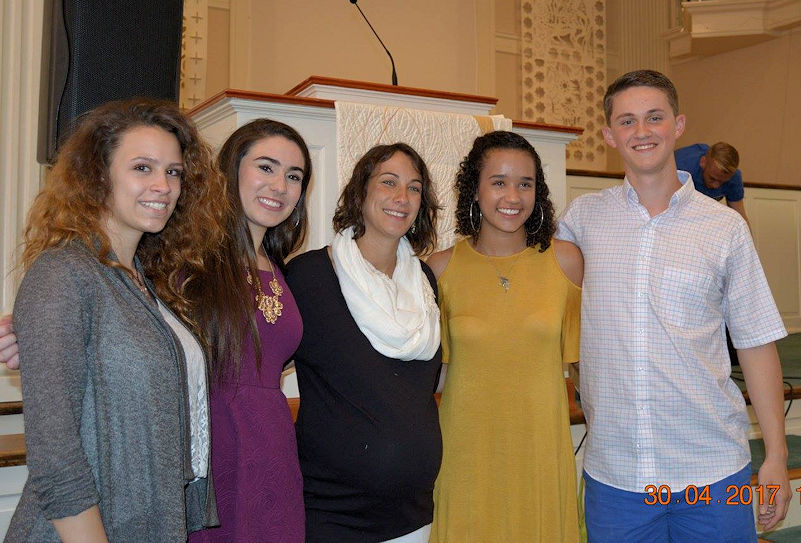Treasure in Clay Pots
by Lin Story-Bunce
Jeremiah 18.1-6; 2 Corinthians 4.5-9
This past week, I was at a leadership retreat with Randy Miller – who you met in worship last Sunday, and several other folks with whom I serve on The Ministers Council of the American Baptist Churches, USA. We have spent the past two years serving together virtually, so in an effort to help us better know one another, we were each invited to lead a time of devotion from a story in our own lives. My friend, Pat, shared this story about her son, Mateo.
She recalled:
One early summer day a number of years ago, her then 8 year old son Mateo was racing his bike with a group of his friends. In the spirit of Evel Knievel, he twisted and turned, jumped and jackknifed, danced and dare-deviled, magically maneuvering that bike.
Ready for the big race, he took his mark, set, and sped for the finish line, which was the “STOP” sign at the end of the street. Only Mateo didn’t stop. With a last burst of speed, he suddenly surged forward, eclipsing the bicyclist next to him. CRASH!!!
The bike went down, a crumpled mass of mangled metal, while Mateo shot up, Evel Kneival let loose. He finally fell from grace on a foot and a half grass meridian, 55 feet beyond the place of impact, a blur of blue, Chevy, that is.
Ambulance sirens blared. The police were called.
After x-raying every inch of his body, the doctor was amazed to find only one broken bone, not from the fall, but from the impact of the car hitting his leg against his bike. Leg casted from hip to toe, and bike rides—not to mention flights of fancy—a long way off, they shared their glimpses of relief.
Pat didn’t think Mateo had seen the car coming down the street – but she was wrong. Her son later confessed to that he had in fact seen the car coming but thought he could beat it – a near deadly miscalculation.
As Pat and I reflected over her story and shared stories between us of our children, we were both struck by this false sense of immortality that carries us through our childhood. I’m not sure if our children just have a little more Evel Knievel in them or if it’s in some real sense all children – but I think it is probably latter. Our children move through the world with a emboldened sense of confidence – jumping from higher steps than they should – testing the limits of their ability – superhero diving from tabletops and monkey bars – still quite unaware of the dangers that might await … believing all the time that they are unstoppable, untouchable, unbreakable.
But we are not made to be immortal or unbreakable. Whatever else we believe about ourselves – however hard we might try to convince ourselves or the world around us otherwise – we are made from dust –
in the beginning, God crafted human kind from the dirt of the ground and the dust of the stars to become clay vessels that carry within us the very breath and life of our creator. As our 2 Corinthians verse says, we are the clay pots in which God has trusted God’s treasure.And yet – we spend an incredible amount of energy trying to be anything other than this – anything other than fragile, comparing our blooper reels to other people’s highlight reels or instagram stories; our cameos to other peoples headshots.
We work hard to photoshop the version of ourselves and of our lives we are willing to let the people around us see. We protect ourselves with perfectionism and judgment, proving our self-worth, and out-performing those around us all in an effort to keep everyone else from knowing our screw-ups, our imperfections, our fears.
Somewhere along our human journeys we’ve absorbed the message that we are not enough just as we are – that we are only worthy of being loved, of being seen, of being understood – if what we have to offer of ourselves is nicely put together; if our baggage is manageable; if our lives, our interests, our bodies are appealing; our personalities don’t take up too much space; if our load isn’t too heavy for those around us to experience or carry
And in our efforts to keep up this narrative – we have hindered our ability to be in authentic relationships with ourselves, with each other, and with God.
When Jeremiah serves as prophet to Israel, it is during the most tumultuous time of Israel’s history. Israel is in a cyclical pattern of disobeying God, enduring defeat, suffering exile – all while Jeremiah is trying his best to convince Israel to listen to him. He is thought of as both the best and worst prophet. He right in all his prophecies – and yet Israel never listens to him. In that way, he sees himself as a failure and even curses the day of his own birth.
In this verse we read this morning, Israel has turned from faithfulness to God – but Jeremiah is losing his faith in God, too. Why has God called him to this? What is the point?
In an unexpected turn, God instructs Jeremiah to leave his own familiar spaces – to step away from the scriptures and the sacred places, and instead learn about God by watching an artist at work. Like a potter with clay in her hands, God knows us intimately – the imprint of God’s hands make smooth our shape – and we are never finished in God’s making. But in our living we are shaped and reshaped through the work and love of the potter. This truth is not just for Israel, but is for Jeremiah, too.
Jeremiah feels completely alone. He is a scorned prophet – who is ridiculed by the nation he serves. Yet here, God sees him in his brokenness, and promises that the potter of God’s people not only sees his pain, but is continually holding, reshaping, and mending the cracks of our lives.
Leonard Cohen once wrote:
Ring the bells that still can ring
Forget your perfect offering
There is a crack in everything
That’s how the light gets in.
Allowing oneself to be known so completely is absolutely terrifying! But allowing oneself to be seen and known – and allowing oneself to fully see and know another – is the core, the heart, the center, of meaningful human experience.
A few years back, we led a sermon series at College Park called Kinsukoroi. Kintsukoroi or Kintsugi is the Japanese practice of repairing broken ceramics using lacquer and gold pigment. The practice likely stems from the Japanese philosophy of wabi – a term that describes the beauty of imperfections. Kintsugi is a practice that enhances the durability of a cracked ceramic – while also allowing the broken places in a ceramic piece to become it’s own part of the art. Contrary to popular understanding – in the practice of kintsugi, the gold pigment is not included in lacquer but is actually painted on after the cracks have healed – making the visibility of the cracks an even more intentional choice.
When we allow our broken and healed places – our imperfections and our mistakes – to be known: it honors the fullness of our stories; It holds us accountable to our history; It recognizes the pain of our past; It holds sacred the arduous human journey of being and becoming – at every stage; It reminds us that the resurrecting power of a loving God is already and always at work in our lives.
The same spirit that brings life from an empty tomb – is also piecing together new life shards of our broken vessels.
The same redemptive spirit that compels fishermen to drop their nets, and brings to the table the sick, the hungry, the dying, the cast out, that lifts up the lowly and humbles the proud – also offers us radical welcome and belonging, creates and sustains our very lives, and shaping us each one into our better and truer selves.
The same transformative spirit that broke open creation in holy possibility – is mending together hope in the midst of despair. Even within the chaos; even when the world is falling apart around us; even when life is swallowing you whole; even when we think humanity is broken beyond redemption.
This is the scandal of our sacred scriptures – that God entered into our world in the form of a fragile clay pot to know our brokenness through God’s own brokenness.
But we have this treasure in clay pots …
It is in our limitations that the intimacy, the love, the grace, the redemption of an ever loving God is made fully known – and it is in our shared brokenness that we better understand our connection to and our dependence upon one another.
Brene Brown is a sociologist who has invested the past twenty years of her research to work around shame and vulnerability. She says that, though vulnerability is often seen as weak, can be absolutely terrifying, allowing oneself to be seen and known – and allowing oneself to fully see and know another – is the core, the heart, the center, of meaningful human experience.
What if instead we spent less time trying to cover up own own cracks, and instead put our energy and time into seeing each other and ourselves in our entirety – our history, our cracks, our imperfections, our fears – all of it?
To say to another – I see you.
I see you rising early to pack your child’s lunch and then heading off to work while he is still sleeping.
I see you walking through the steps of recovery as you still struggling through addiction.
I see you waiting anxiously to hear back from your college application or your 10th job interview.
I see you choosing to be who you are or love who you love without the support of your family.
I see you keeping your pain of infertility or miscarriages to yourself because no one really talks about those things.
I see you waffling through those teenage years trying to find your own style, your own voice, your own passions.
I see you cheering on your daughter as sets off on her dream job not sure if it will actually pan out alright.
I see you carrying quietly the burden of your anxiety, depression, ocd because of the fear of what others might think.
I see you figuring out who you are now that your kids are grown or now that you are retired from a job that has defined your days for most of your life.
I see you receiving the results of your scan, going on your first date after your divorce, saying “I love you” for the first time.
Vulnerability is about the willingness to see our lives and truly be seen in our lives. It is the means by which we are able to receive and experience grace..
This kind of vulnerability allows those who have lived through unspeakable trauma to move toward healing without carrying the burden of shame.
This kind of vulnerability creates space for repentance, forgiveness, and transformation.
This kind of vulnerability in our communities lays a foundation for the deep listening and accountability that can heal the fractures in our communities.
This kind of vulnerability transforms our souls and gives us the courage to paint gold over the mended cracks of our own clay pots.
______________________________________
There is an ancient story that has carried on in many traditions around the world. It goes something like this:
There once lived a water carrier. Every morning, as soon as the sun rose, she walked from her home to collect water in two earthen pots that hung from a long pole that she carried across her shoulders. One pot was perfectly formed, the other, although the same shape and size as its counterpart, had a crack in its side. So, whenever they returned to the water carrier’s house it was only ever half full.
For years, the water carrier repeated her journey to and from her house collecting water from the river. As the years passed by, the cracked pot created a story in its head about its level of worthiness and inability to properly perform the job for which it had been created. Eventually, the pain and shame that it felt about its own perceived imperfections, became too much for it to bear. So, one day as the water carrier knelt beside the river and began her usual task of filling the pots with water, the cracked pot found its voice and said;
“I am so sorry. For years and years, I have watched you fill me with water and I can only imagine what a fruitless task it must be for you. As whenever we return to home, I am only ever half full. While in comparison, the other pot is perfect, rarely does it lose a drop of water on our long walk back to our home, but me, I am far from perfect. This crack in my side, not only does it cause me so much hurt and shame, but it must also cause you to want to get rid of me. Surely, I am only making this long, arduous job that you do each day, that much more difficult? I can understand if you are thinking of getting rid of me and replacing me with another perfectly formed pot.”
The water carrier listened to these words with both care and compassion. The cracked pot’s story of unworthiness and shame was not one that she recognised. For this was not what she thought of the pot. She knew about the crack, but did not see it as an imperfection, or as something that made it less worthy than the other pot that hung from her shoulder.
Gently she turned to the pot and said, “On our return walk home, I want you to look up and to the side of you. For too long, it would seem you have been looking down, comparing yourself to others and not noticing how you and the crack that you have in your side has brought untold beauty into my life”
Puzzled, the Cracked pot wondered what on-earth her words meant. She seemed to be suggesting that its story of lack, unworthiness and shame, was in some way faulty. As to how this could be, it could not comprehend.
However, the Cracked Pot trusted the water carrier. It occurred to it that in all the time that it had journeyed with her, she had never said a harsh word, never scorned or ridiculed it, but had always shown a sense of gratefulness and care when filling it with water.
So, on the return journey it heeded the water carrier’s words. It looked up and it looked out. In its former depressed state, it had not noticed that along the path that they travelled there was a dazzling array of beauty, colour and life. The water carrier in her wisdom, knowing of the crack in the pot’s side, had sprinkled seeds along the path. These seeds were duly watered every day as a result of the crack in the pot’s side and the path that had once been barren and devoid of life was now resplendent with an array of beautiful wild flowers.
Now, the cracked pot understood. Now the cracked pot began to see itself in a new light. Now it understood that indeed it had been telling itself a faulty story. If its experience of being a ‘cracked pot’ was going to change then it would have to change the story that it was telling itself.
____________________________________
We have to stop telling ourselves the story that we aren’t good enough.
We are worthy of being seen and known – not in part but in full. To see our full story. To see the full story of those around us. And to know that we are fully and completely – as we are – an integral part of the wonderful story of God. Knowing that our lives are the treasures of God held in the fragile vessels of clay pots that are continually reshaped and mended – held in the loving hands of our potter and creator – the one who made us in the beginning.


